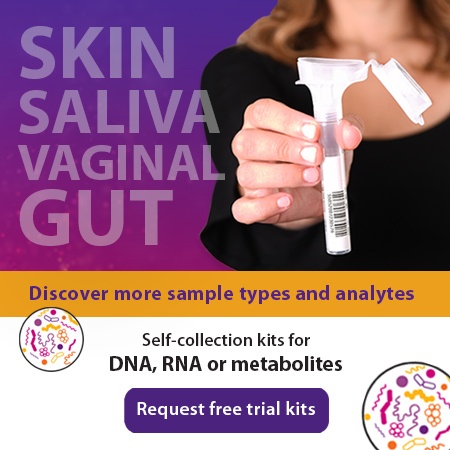2018-06-12
With a growing number of research studies showing associations between the gut microbiome and disease, this is a burgeoning field with fundamental questions that still need to be understood. The gut microbiome is composed of the community of microorganisms that dwell in our intestinal system, and elucidating the significance of this rich and diverse ecosystem is of great importance to human health. Large-scale studies with the sheer statistical power and immense volumes of data able to show strong correlations and draw meaningful conclusions are needed in this booming area of discovery.
Optimizing the collection of gut microbiome samples in studies with large cohorts will enable highly efficient study management and help to generate valid results following downstream analytics.
DNA Genotek has gained extensive experience working with human and microbial genetic researchers over the past 15 years on both sample collection solutions and optimized study design. We’ve been privileged to work closely with academic and industry leaders on thousands of different genetic projects. We’ve observed the following top 10 essential considerations when designing and implementing large-scale microbiome projects that are worth considering.
1 - Simple collection methods
In order to maximize donor compliance and collect the number of microbiome samples needed for large-scale cohorts, the collection process needs to be fast, easy and non-invasive. Furthermore, compliance can be augmented by providing user-friendly collection instructions that are clear and easily understood with minimal room for interpretation or confusion. It is worth considering instructions in larger fonts, simplified wording, language translations or even visual graphics/videos to appeal to a diverse population. A final point to consider is the safety of the collection method, meaning the chemistry is non-toxic and safe for participants to handle during the collection process.
2 – Maximize donor recruitment
Recruiting participants for gut microbiome studies is particularly challenging because the sample type is stool. This means that an individual cannot just provide a sample on-demand as one could with more accessible sample types like blood, saliva or buccal swabs. Providing a collection method that can be completed from the privacy and convenience of the home is necessary. There are other considerations, however, most notably the ‘ick’ factor associated with collecting, storing and transporting samples immediately post collection at home. Storing a stool sample in a personal freezer is certainly not optimal, and neither is the logistics of having dry ice and proper insulated packaging at home. This is where having a collection method able to be immediately stabilized at ambient temperature in the comfort of home, such as OMNIgene•GUT, is a very obvious choice to maximize subject recruitment by greatly simplifying the entire sample handling experience.
3 – Motivate donors
People will be more willing to participate in a research study where they feel they are positively contributing to research of importance and high merit. This is especially true for studies involving the collection of stool samples for gut microbiome studies. To motivate participants, clearly explain why the study is important and how the donors are personally helping to attain the study goals. Providing small incentives that are not considered coercive by your human research ethics committee may also help.
4 – Highlight the importance of your research
Especially for large studies, marketing is the one area that is often overlooked during study planning and is critical in recruiting subjects in the timeframe needed to be successful. Logically, if people haven’t heard about your study, they cannot decide to join. Creating a unique brand for your study with clear messaging and enticing visual graphics can catch the attention of potential donors. DNA Genotek offers a complete customization option to create a specific and tailored collection package (i.e. sample kits, graphically appealing collection box, user instructions and other support material) to positively engage the donor and reflect your research goals. Furthermore, reaching out to local advertising in the media, as well as creating a project website can help get your message out to a larger demographic, which increases the chances of bolstering subject numbers.
5 – Standardize collection method
It is imperative to have a standardized method of sample collection for large studies to minimize human error and ultimately allow for meaningful data to be obtained from the sample analysis. In the case of gut microbiome studies where self-collection is an option or where samples are sent to multiple laboratories for analysis, this point becomes even more critical. OMNIgene•GUT is a standard volumetric device that eliminates the need to weigh the sample and eliminates aliquot bias. Furthermore, the sample is rapidly homogenized and stabilized at the point of collection.
6 – Generate the highest quality microbiome samples
Regardless of study size, it is essential to collect high-quality microbiome samples to allow meaningful and reproducible conclusions to be drawn from the research. Microbiota profiles can change very rapidly immediately following collection due to microbial growth and DNA degradation, which can invite unwanted bias and inaccuracies into a study. It is imperative to accurately represent the in vivo status of a microbiome sample by preserving a snapshot of the gut microbial ecosystem. This is necessary for neutrality and sample stability. The sample must be immediately preserved and not allowed to change over time, even after multiple freeze-thaw cycles.
7 – Streamline sample transport
To avoid logistical nightmares, prevent headaches and save money during sample transport, choose a collection method that stabilizes the gut microbial snapshot at ambient temperature for a reasonable amount of time. Cold-chain transport of samples on dry ice involves expensive packaging and complicated logistics, and risks samples being held at the border, freezers breaking, and refrigerated trucks not being cold enough, which can lead to multiple freeze-thaw cycles and the loss or degradation of precious samples. Collection devices that immediately stabilize at point of collection permit samples to be collected in remote areas where immediate access to proper infrastructure is not available.
8 – Use Barcodes for sample traceability
When handling very large numbers of microbiome samples, a sophisticated labelling system to identify, catalogue and track each sample throughout the entire collection, extraction, analysis, storage and disposal process is indispensable. Barcodes for donor sample traceability provides a simplified, scalable and efficient solution that minimizes the potential for human error and costly mix-ups.
9 – Choose scalable collection solutions
When processing large numbers of samples, you need to choose a collection device that allows your project to scale. Samples need to be automation-friendly allowing high-throughput processing. Choosing an option where the sample is in an easy-to-work-with liquid sample readily pipetted, rather than complex frozen or heterogeneous fresh stool samples that require complex processing, can be a time and cost saver.
10 – Benefit from Collaborative Research
Selecting validated, standardized collection methods proven to work in a wide variety of environments with a diverse spectrum of donors will allow you to easily share and compare data with other research cohorts without having to deal with geographical/environmental bias or technical variability introduced by suboptimal collection methods. Choosing to work with companies providing collection devices and experimental supplies with regulatory experience, high quality standards and impeccable reputations can provide invaluable scientific advice and end-to-end customer support.
If you'd like to conduct a project of your own using OMNIgene’s state-of-the-art methods, click here.


